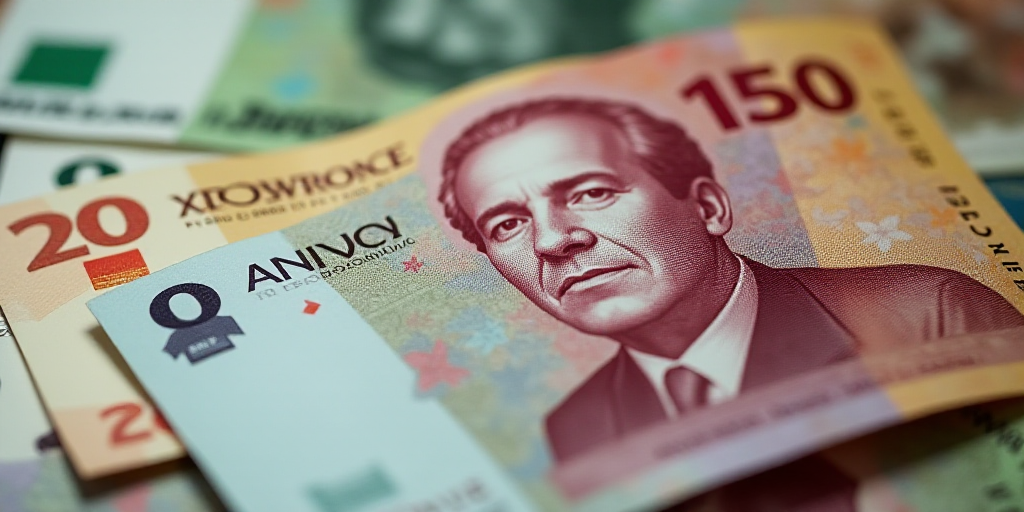Background on the Mexican Peso and its Recent Performance
The Mexican peso has weakened against the US dollar in recent weeks due to growing expectations that the Federal Reserve will resume its rate-cutting cycle at their September meeting.
Weekly Performance
According to data from Banco de México (Banxico), the Mexican peso closed at 18.7412 pesos per dollar, a 0.40% appreciation or 7.47 centavos on Friday, following two sessions of depreciation.
On a weekly basis, the Mexican currency depreciated by 0.75%, with the exchange rate hitting a low of 18.5803 pesos per dollar, un value not seen since July 23rd, and a high of 18.8159 pesos.
Year-to-date, the Mexican peso has appreciated by 10.26%.
Global Currency Performance
The Intercontinental Exchange’s Dollar Index (DXY), which measures the greenback against a basket of six reference currencies, fell 0.34% to 97.85 points during the week.
Among major currency pairs, the Argentine peso gained 2.05%, the Israeli shekel rose by 1.60%, the Colombian peso appreciated by 0.87%, the Norwegian krone gained 0.87%, the Indonesian rupiah increased by 0.80%, and the British pound rose by 0.76%.
On the other hand, the Peruvian sol depreciated by 1.02%, the Mexican peso fell by 0.75%, the New Zealand dollar dropped by 0.57%, the Taiwanese dollar declined by 0.53%, the Canadian dollar weakened by 0.44%, and the Turkish lira lost 0.44%.
The weakest point was reached on Wednesday following the release of US consumer price index for July, which increased expectations that the Federal Reserve will resume its rate-cutting cycle at their September meeting.
Expert Analysis
Gabriela Siller, Director of Analysis at Banco Base, explained that after this point, the peso began to depreciate, eventually closing as the second-biggest loser against the dollar for the week.
“A corrective upward movement occurred due to low exchange rate levels triggering anticipatory dollar purchases and currency hedging, which raised the exchange rate,”
said the expert.
She also highlighted the release of producer inflation data, which “reduced expectations that the Federal Reserve will cut interest rates before the end of the year”.
Investor Positions on the Mexican Peso
Speculative net long positions for the Mexican peso remained unchanged in the Chicago Mercantile Exchange (CME) futures market.
The CME closed the week with 68,100 contracts, identical to the previous week’s figure, indicating notable stability in international investors’ stance towards the Mexican currency.
Felipe Mendoza, Financial Markets Analyst at brokerage ATFX LATAM, pointed out that this lack of change contrasts with previous weeks when significant movements were observed due to expectations of US monetary policy and domestic economic data in Mexico.
“The absence of changes this time seems to be a response to an environment where, although there are global volatility factors, the market has preferred to maintain a wait-and-see stance rather than undertake significant repositioning,”
wrote the analyst.
Key Questions and Answers
- Q: Why has the Mexican peso weakened recently? A: The peso has weakened due to growing expectations that the Federal Reserve will resume its rate-cutting cycle, following the release of US consumer price index data for July.
- Q: What is the weekly performance of the Mexican peso? A: The Mexican peso depreciated by 0.75% on a weekly basis, closing at 18.7412 pesos per dollar.
- Q: How have other major currencies performed compared to the Mexican peso? A: The Argentine peso, Israeli shekel, Colombian peso, Norwegian krone, Indonesian rupiah, and British pound appreciated against the dollar, while the Peruvian sol, Mexican peso, New Zealand dollar, Taiwanese dollar, Canadian dollar, and Turkish lira depreciated.
- Q: What are investor positions on the Mexican peso? A: Speculative net long positions for the Mexican peso have remained unchanged in the CME futures market, indicating stability among international investors.






